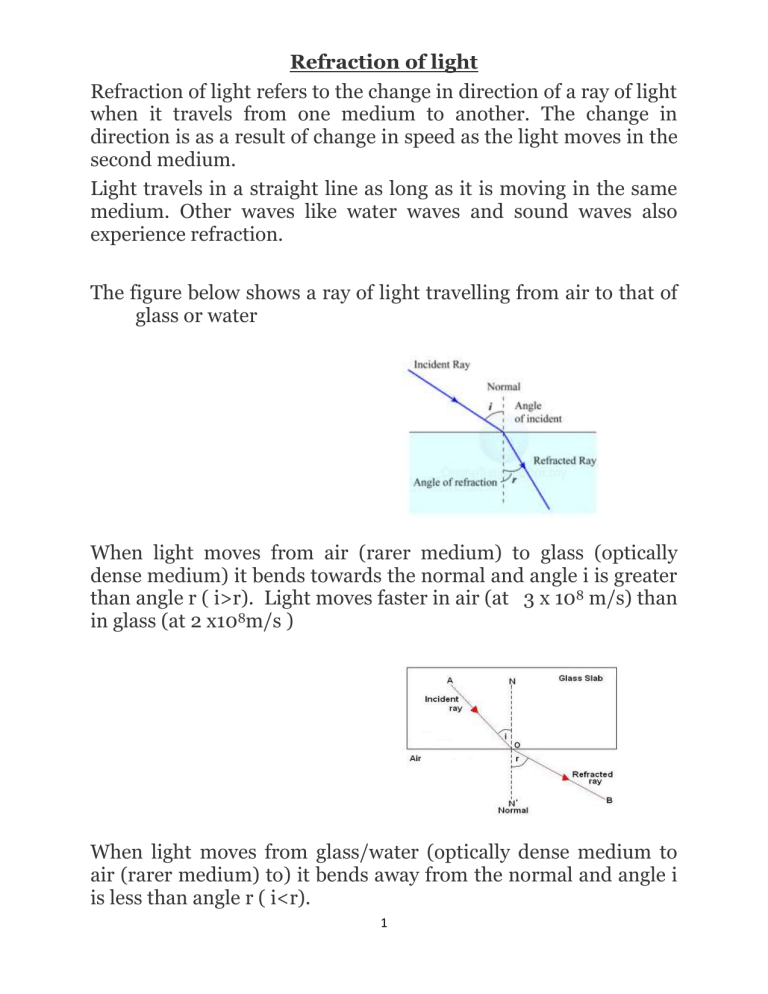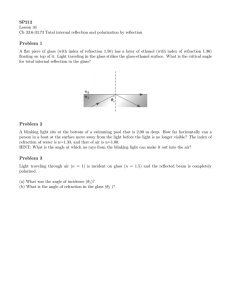Refraction of Light: Principles, Examples, and Applications
advertisement

Refraction of light Refraction of light refers to the change in direction of a ray of light when it travels from one medium to another. The change in direction is as a result of change in speed as the light moves in the second medium. Light travels in a straight line as long as it is moving in the same medium. Other waves like water waves and sound waves also experience refraction. The figure below shows a ray of light travelling from air to that of glass or water When light moves from air (rarer medium) to glass (optically dense medium) it bends towards the normal and angle i is greater than angle r ( i>r). Light moves faster in air (at 3 x 108 m/s) than in glass (at 2 x108m/s ) When light moves from glass/water (optically dense medium to air (rarer medium) to) it bends away from the normal and angle i is less than angle r ( i<r). 1 When light is incident normally ( i= 0o) it slows down but there is no change in direction During refraction of light: 1. 2. 3. The frequency of the refracted ray remains constant. Due to partial reflection and absorption of light at the interface, the intensity of the refracted ray will be less than the incident ray. When the light crosses the boundary between two different media, deviation of light occurs resulting in refraction such that there is a change in wavelength and speed of light. Effects of Refraction Twinkling of stars is due to refraction of light. Mirage and looming are optical illusions which are a result of refraction of light. A swimming pool always looks shallower than it really is because the light coming from the bottom of the pool bends at the surface due to refraction of light. 2 When light is incident to a surface of a glass block, it gets refracted as it gets into the block. The same happens as the light crosses from the block to air again. For a glass block with parallel sides the path of light is as below. Refractive index Refractive index is the measure of bending of a light ray when passing from one medium to another. Refractive index n is defined as the ratio of the sine of the angle of incidence to the sine of the angle of refraction; i.e., n = sin i / sin r. Refractive index can also be defined as the ratio of the velocity c, of light in empty space to velocity v in a substance, n = c/v. 3 Example 1. Light incident at an angle of 40o to a boundary between air and glass makes an angle of refraction of 25.3o . Calculate the refractive index of glass. n = sin i / sin r = sin 40 /sin 25.3 = 1.5 2. The speed of light in air is 3x108 m/s. What is the speed of light in a material whose refractive index is 1.5 n = velocity in air/ velocity in medium 1.5 = 3 x 108 / v 1.5v = 3 x 108 V = 3 x 108/ 1.5 V = 2 x 108 m/s. Total Internal Reflection This is the complete reflection of a light ray reaching an interface with a less dense medium when the angle of incidence exceeds the critical angle. 4 When light passes from a material such as water into one of lower refractive index such as air, there is a maximum angle of incidence in the water that will give a refracted beam at an angle of refraction is 90o. critical angle C is the angle of incidence in the denser medium corresponding to an angle of refraction of 90o in the less dense medium. The reason for this is clear if we consider the formulae. For an angle of refraction of 90o we have: 2n1= sin i/ sin r = sin c/ sin 90 = 1/1n2 For any material with refractive index is n n = 1/sinC Example What is the critical angle of glass with a refractive index n = 1.5 n = 1 / sinc 1.5 = 1 /sinC SinC =1 /1.5 = 0.67 C = 42.1o 5 The conditions for total internal reflection are i. the light is travelling from an optically denser medium (higher refractive index) to an optically less dense medium (lower refractive index) ii. the angle of incidence is greater than the critical angle. Application of total internal reflection The phenomenon of total internal reflection of light is used in many optical instruments like telescopes, microscopes, binoculars, spectroscopes, periscopes etc. The brilliance of a diamond is due to total internal reflection. Optical fibre works on the principle of total internal reflection The incident light into the fibre gets repeatedly totally internally reflected until it exits from the opposite end of glass rod. This is used in endoscopes and telecommunications 6 LENSES Lenses can be divided into two according to their effect on ligh converging lenses – are fatter Iin the middle than at the edges diverging lenses – are thinner in the middle than at the edges converging diverging Converging lens It is a convex lens in which light rays that enter it parallel to its axis converge at a single point on the opposite side. A lens produces its focusing effect because of the refraction of a light beam entering and emerging from the lens into the air. 7 Main terms for lens: Focal length, f is the distance between the optical centre and the principal focus. Optical centre is the point midway between the lens’ surfaces on its principal axis. Rays passing through the optical centre are not deviated. Principal axis is the line passing symmetrically through the optical centre of the lens. Focal point, F is the point to which all rays close to and incident parallel to the principal axis converge after refraction by the lens. Focal plane is the plane which passes through the focal point and is perpendicular to the principal axis Formation of image by converging lens When an illuminated object is placed on one side of the lens and a screen (paper) placed on the other an image of the object may be seen. This can be explained using a ray diagram Ray diagrams The two rays used are i. from top of object through the middle of the lens undeflected ii. from top of object parallel to the main axis of the lens. As it passes through the lens it gets deflected to pass through the principal focus The point where the two cross is the position of the top of the image. This is a real object because it forms on a screen. 8 If the object is brought closer to the lens and placed between it and F, the image forms on the same side as the object. It is said to be virtual as it cannot form on a screen. It is upright, magnified and further away from the lens than the object. The rays are extended backwards to find the position of the image. This is the form in which it is used as a magnifying glass 9





